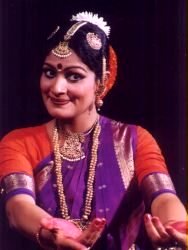
|
 |

|
 |
SEVENTY YEARS OF BHARATANATYAM by Geeta Chandran, New Delhi e-mail: natyavriksha@hotmail.com |
| Jan
3, 2003
According to E.R. Krishna Iyer, who was closely associated with the revival of Bharatanatyam, the date 1 January 1933 was to be taken as the date of the renaissance of Bharatanatyam. 1 January 2003 thus marks the seventieth anniversary of one of the most unique cultural restorations of dance encountered anywhere in the world. In these seventy years everything about the dance changed. From being a fragment of history shriveling in the margins of impoverishment, Bharatanatyam empowered itself to become the ubiquitous Indian classical dance. From a surreptitious caste bound practice, it became a wondrous art form that tore its caste and regional definitions to capture the entire nation's popular and critical imagination. From being a fragile ritualistic dance that had originated in the temples of South India, it became a vehicle for flagrant performance. From a secluded and sacred art, it became public. From temple lintel to proscenium stage it became an object of celebration, and some abuse. The democratization of the dance has been one of the key features of this renaissance. Eagerly accepted by conservative (read Brahmin) society of Madras, the dance went on to break all geographical boundaries to gain pan-Indian acceptance. Bharatanatyam dancers from Kashmir are not rare; why even across the nation's geographic borders, the dance has become a symbol of Indian culture and in every major and not so major cities of the world, Bharatanatyam flourishes and is celebrated as containing the larger essence of Indian culture. The dance has also crossed its gender connotations and male dancers today are equally celebrated as artists. All facets of the dance are being explored - its geometry, its narrative potential and its expressional capabilities. To much of the world, the ability of the dance to be a carrier of myths has been one element of its popularity. Its glamour, recreated from film and temple panels arouses popular imagination. Every dancer could be an apsara! The dance was newly cloaked by improvements in sound, light, and stage technologies. The aesthetics of every decade and the improvements in each of these fields impacted the dance. And the personalities and personal histories of the dancer-practitioners impacted the meanderings of the art form. Also, the intellectual component of the dance was finely honed, as the dance itself got empowered by empowered dancers. Great strides were made in the teaching of the dance. From being a sacred art imparted from Guru to Shishya, classroom teaching became the norm, and institutions, both state-funded and private, sprung all over to teach the dance. The teacher-student relationship became less starchy, and a more collegial, and probably more informal, teaching methodology suited to contemporary learners was evolved. The dance also received extensive state patronage since it became closely identified with the image of the newly independent India. The new country had a vibrant classical dance form! Let's celebrate. Many artists did yeoman service in popularizing the dance; some need special mention: Kamala Laxman was synonymous with the dance propped no doubt by her linkages with popular cinema. And in the north, the redoubtable Yamini Krishnamurthi became its most endearing icon. As time meandered several dancers contributed to the growth of the dance form. Its scholarship, documentation and critical base were enlarged. It became subject of seminars, retreats and discussions. Today the dance is at another crossroads. Serious dancers are attempting to break the structural routines that held so well for the past half century, to evolve new perspectives that reflect their individualized creativity. Given proper stewardship, Bharatanatyam can grow even more to become a truly innovative art form beyond being a mere footnote to the grandeur of Indian culture. Can we invest in such risks? Future will be the judge. |

Bharatanatyam dancer Geeta Chandran is the artistic director of Natya Vriksha in New Delhi. |